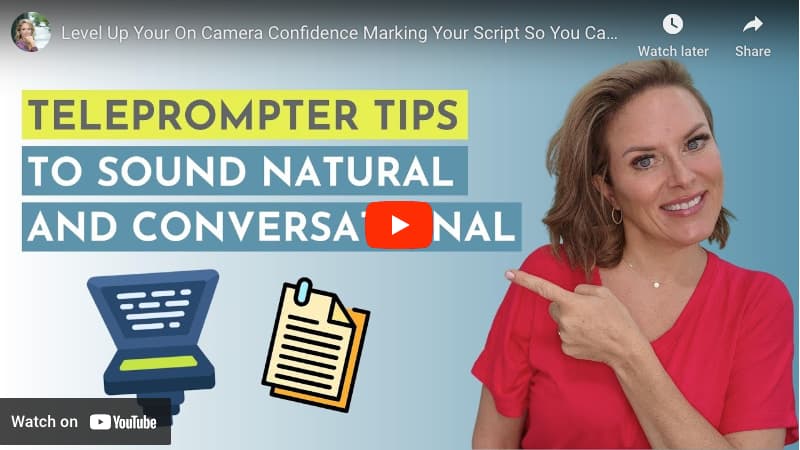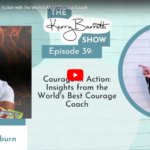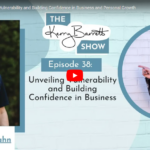
Your video content doesn’t end with just writing a good script and setting it up on a teleprompter! It all leads to the most important part—the delivery. 🗣
In this video, we’re going to work on your on-camera presence and learn the art of delivering a script with confidence and without sounding like a robot. Conversational skills are key when it comes to keeping viewers’ attention and leaving a lasting impression for the right reasons! ✅
Transcript
Kerry Barrett 07:24:19
So you’ve got a great script. And if you don’t check out this video that will teach you how to craft one. A lot of people think it’s just as easy as plugging that script into their teleprompter or reading their script or notes that they have somehow, like connected right below the lens right below the camera. Those are not good ideas. That’s basically a DIY prompter. And the truth is, even though well now, former news anchors like myself are called derogatory names like camera jockeys and lens meat and talking heads. The truth is, there actually is a real skill that comes with delivering a script that doesn’t sound like you’re reading or does it sound like you are, you know, a robot dug into a wall, there is a nuance, and it takes practice. But there are some really easy things you can do to help you with that practice. And make sure that your delivery sounds incredibly conversational. If you do this wrong, you are going to be memorable, and you will be the subject of conversational jokes. But none of this will be in a good way you want to be memorable for the right reasons. So let’s assume that your script is conversational, that it is written in a casual tone, the way that we speak. And it’s not written as if it were a white paper to be delivered on camera. Let’s make all of those assumptions at this point. So now you need to use the words that you have on your script and the skills that you’ve learned about delivering on camera to make that script conversational, casual, helpful, memorable, interesting. One of the things that that means when you’re going on camera is to use your vocal range and your vocal variety, which is hard for Oct well, because we’re not actually talking to a person that’s standing in front of them. And when people get in front of the camera, they have a tendency to want to make themselves diminished, which means that their vocal variety begins to reduce. Usually that applies to body movement and body language as well. We have a tendency to want to like roll up and not draw attention to ourselves, which is not what you should be doing on video. When you are deeply in thought trying to deliver a script and don’t overthink it, it’s easy to focus on the words that you have in front of you and getting them out accurately. And we lose connection then to what it is that we’re saying. Because we can’t do all of these things all at one time, unless we are very skilled at being a camera and reading a teleprompter. And we have a deep and thorough understanding of that about which we are speaking which you should. The key here though, is to create some visual cues so that even when you are deep in thought, you can sort of put that vocal variety stuff on autopilot, and it will cue you your script anyway as to when you need to pause or when you need to uptick or when you need to slow down to make a boy so I’m going to teach how to do all those things. So while reading from a teleprompter isn’t an excuse to put your brain on autopilot marking your script will allow you to deliver more conversationally without actually having to put a lot of thought into remembering the tone or the inflection or where you should be smiling or where you should be speeding up or slowing down cues you to all of that something to remember before we jump into the basic of marking your script is the one mistake that many people make when they’re reading from a teleprompter or reading the script is that they slow down, they don’t speak at their natural rate of speech. And really quite frankly, for video, you should be speaking probably a little bit more quickly than normal anyway, but people get so focused on getting the words out that they begin to slow down. So a couple of things, number one practice and that and the reason that you have to practice is because even though you don’t notice it, your viewers will and from the moment your video starts, you have to sort of jump out of your chair and as I like to say land in their lap and direct their attention if you are speaking so slowly, you give their mind.
Kerry Barrett 07:28:36
See,
Kerry Barrett 07:28:38
as a dramatic effect, a chance to wonder if we can actually understand words at the rate three times at which we are able to speak now. I don’t suggest trying to do that. But what I do suggest is keeping that in mind as you read the prompter so they don’t slow down and get incredibly boring. So let’s begin with taking the script that you have and sort of speaking it if you will. So speaking that script and actually saying it out loud and talking it if you will, and wondering and thinking about whether that is in fact how you would actually say that particular thought sentence paragraph if you were having this conversation with somebody in real life so sometimes they
Kerry Barrett 07:29:19
helps to just talk about the information, don’t necessarily read it, but add limits and think about it. That way, you’re not going for perfection. And I would record some of this on your phone’s voice recorder so that you can go back and you can listen to the way that you actually are delivering about this particular topic when you’re not reading off of a script, and then read your script, actually onto a voice recorder. And notice the difference. So where you find yourself speaking naturally, where you naturally speed up, where you naturally slow down, where you get excited about something, those are the things that you want to replicate and emulate when you are speaking on camera. So knowing where you naturally do those things is number one, there are a couple of best practices speeding up when things are not necessarily urgent, slowing down when you need to bullet point doing this thing, number one, number two. And number three, those are good reasons to slow down the power of the pause or micro pause. While there is no one right way to mark a script, these are some of the things that worked for me when I was in the news industry to give you some ideas. So for example, I use an ellipsis where I need to pause or slow down, I will bold things or underline or use Asterisk around words that I want to emphasize, I might use an x for every beat of a pause, you know, instead of an ellipsis with three dots, maybe I use an x to signify that I need to pause for one second or two x’s to pause for two seconds. I like to use parentheses for keeping particular thoughts together. You can use quotation marks to add inflection, and then insert some space for thoughts that you have completed. When I’m reading from a teleprompter I write my scripts rather than one thought per sentence, then each sentence becomes its own paragraph. Now I want to give you a few quick notes about reading naturally. And conversationally, sometimes, especially when somebody has prompter glare where they are afraid to look away from the words for fear that they will jump off of the prompter and run out of the room
Kerry Barrett 07:31:45
kind of staring contest, people can see your eyes move back and forth. And there’s a couple of ways that you can help to cover that up. Number one is to move your head. So if I’m reading a script, and I’m going along like this, as I’m reading that script, you can clearly see that my eyes are moving and movements are part of your natural nonverbals. And the benefit here is that those natural things, those gestures, they actually cover up some of that iden movement as well. You can also step further away from the lens so that the focus is not so obvious when you are reading back and forth. But be aware that you then remove the ease with which your audience can look into your eyes and feel like you’re talking to them. Number two is to read out loud, not silently reading in your head as you’re going over the script but actually saying the words so that you can hear them and you can make it a little more conversational. The bonus here is that you will also find unintended tongue twisters and awkward phrasing that you weren’t aware of if you were just reading in your head because you don’t have to say them. And I would practice using closed captioning. This is something you can do even if you don’t have a teleprompter just yet what I like to do and what I did when I first started in the news industry was I would turn on the TV, I would turn off the sound and it would turn on the Closed Captions and even better if this is a dialogue based shows so you know it could be a comedy or drama or whatever it shouldn’t be news or something like that should be a dialogue with characters that are having natural conversations. And you can read those words as they scroll across the screen which will give you a feeling of what it’s like to change your pace and to speak conversationally while you’re reading words. If you want to learn a little bit more about writing a conversational script, check out this video right here and in the meantime, drop your questions and comments below. Share your experiences and let me know how I can help. Thank you for reading. I will see you in the next video.




